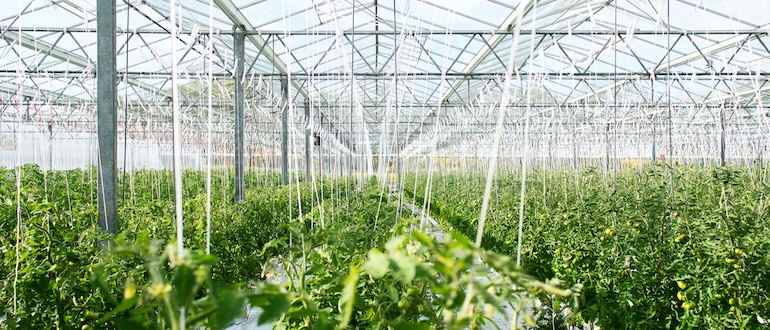
Across the expanse of the behemoth greenhouses owned by Nature Fresh Farms in Ohio and Ontario, rows of vegetation grow in elevated trays, bearing fruits and vegetables all season long.
Bushels of crunchy cucumbers, sweet peppers, ripe berries and flavorful tomatoes make their way from the farms to the tables of shoppers who are treated to premium produce, sustainably grown and bursting with flavors and nutrients. The farm’s secret is the most unexpected: Artificial intelligence (AI).
The company is growing these bountiful gardens amid broiling summers, freezing winters and extreme natural calamities. The hothouses are windowless, climate-agnostic enclosures controlled by programmable AI algorithms.
“We actually come from a very very large farming land, but we only could farm for three months of the year,” told Keith Bradley, VP of Information Technology, in the latest episode of Utilizing Tech: AI at the Edge Podcast with Solidigm, referring to the seasonality of crops and harvest seasons in traditional farming.
“Basically, we were very centralized around tomatoes, but our tomato season lasted about four weeks. So when greenhouses came in, we started to change that from being four weeks to 10 months of the year. Now with artificial lights, we’re producing tomatoes 12 months of the year,” Bradley told.
This is not science fiction. Around the world, high tech farming is shifting the fundamentals of agriculture. Driverless farming vehicles, satellite-guided seeders and fertilizer equipment, and robotic harvesters are eliminating labor shortage, bringing to companies machine power with year-long availability.
And in a wholly ground-breaking way, AI is helping some growers optimize yield and deepen the flavors in their produce.
“We have been growing for almost 25 years now, and AI is just becoming one of the biggest growers for us,” Bradley said.
While most people make a caustic connection between AI and the ecosystem, Nature Fresh Farms is breaking barriers by harnessing AI to control every aspect of the plants’ life and create the most ideal microclimates for the crops to thrive.
“We control everything in the plants’ life from the day it’s born to the day it’s done growing,” he said.
Actuators and sensors sit across the greenhouses collecting data or what is called awareness of the environment. From temperature to lighting, moisture and nutrient levels in the soil to CO2 levels in the air, these devices map and measure everything to microsecond precision with machine vision.
Every second, this data is streamed into compact edge servers installed around the greenhouses — tucked under conveyer belts, fitted next to the packing lines, and placed in spaces adjacent to the plants — for analysis.
Each plant averages out to anywhere between four and five megabytes of data a week, Bradley said. For a farm that has over 3 million plants within its greenhouse, it totals to a lot of data.
“Why did we start to track all of this? Part of it was even for food traceability. We wanted to know where this pepper came from. So we created a program so we can say this pepper came from row A and greenhouse B picked by this person two days ago.”
The recordkeeping allows farms to meet tightening FDA regulations around food safety, while developing customer trust.
“We’ve now have dates and history going back almost 20 years in some locations,” he said.
Once the data makes it to the local servers, programmed AI algorithms crunch through the information in real time producing analytics that direct the systems to adjust the conditions such that the perfect growing condition is achieved.
For maximum accuracy, Nature Fresh Farms leverages different AI algorithms for different sections of the greenhouse, leading to highly curated analytics for every variety of crop.
However, processing the data is not without challenges. Moving all this data to a cloud data center is cumbersome for the network and a costly process overall, Bradley noted. The time lost in shuttling data back and forth defeats the purpose.
Partnering with hardware vendors like Dell and Solidigm, Nature Fresh Farms is moving data processing natively to the edge. “We’re trying to move that compute closer because of the time differential,” Bradley told.
The company uses Dell VxRail hyperconverged infrastructure (HCI) that is suited for edge deployments. Solidigm solid-state drives (SSDs) provide the platform for storage.
In the recent years, with the rise of AI, SSDs have come to play a key role in AI model training for their high density and throughput, and low latency, emerging as the storage medium of choice for model parameters and checkpointing data. “[SSD] was one of those things that I fell in love with very early because of that processing power and longevity that you end up getting out of them,” Bradley said.
In 2020, Nature Fresh Farms switched to all-flash arrays for its active state information. The results were dramatic. Compute time reduced from hours to minutes, and in some cases, processing happened in real-time, he told.
However, over the years, as greenhouse farming has gained traction for their year-round yields and protection against weather events, a litany of concerns has surfaced around the sustainability of the practice. Environmental pollution from nutrient runoffs, heavy energy consumption and large carbon footprints of the facilities have marred the image, while elevating the upfront costs.
Amid these concerns, Nature Fresh Farms is adopting smart practices to slash emissions and make farming more efficient.
“We start at the simple stuff. When we irrigate the plant, whatever the plant doesn’t absorb, we take back and put [it] into the plant next time. So we reclaim water every moment so nothing goes to waste,” Bradley said, explaining the company’s efforts around conservation.
Additionally, he told, Nature Fresh Farms uses ground coconut husk as the growing medium. Besides having high porosity and a near-neutral pH level, husks are a renewable resource that are abundantly available in tropical countries, making them a sustainable alternative to soil and peat moss.
Efforts are also being made to make the greenhouses more energy efficient and sustainable. “We have a large amount of natural gas that we use to produce heat…We take the [CO2] and give it to the plants because that’s a natural stimulant, and then they give out O2 after they absorb it. So in every part of our process, we are doing something to keep it sustainable.”

